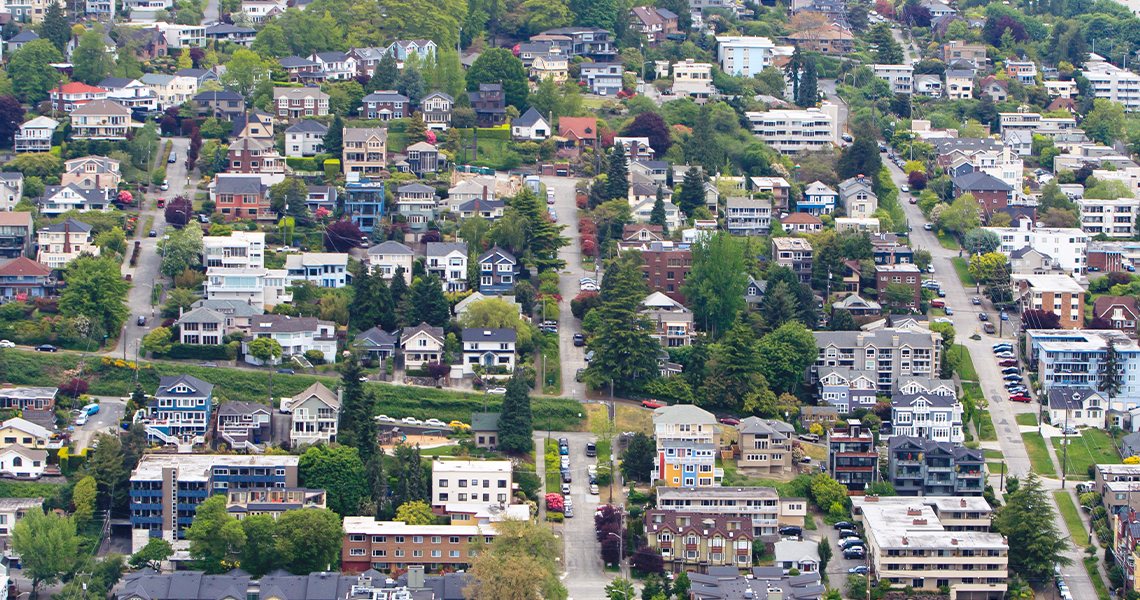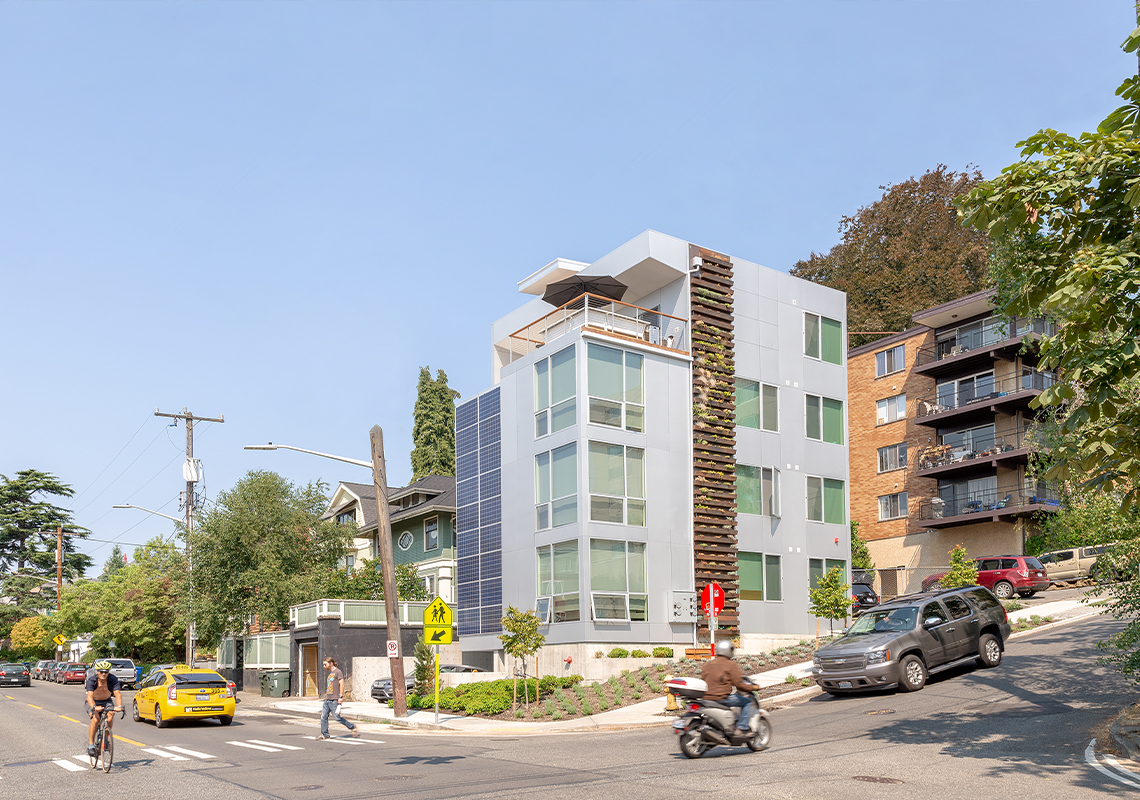By MBAKS Content Strategist James Slone
What happens when inclusionary zoning works against affordability? Just ask Seattle.

Like many urban areas in the United States, the Puget Sound
region has become unaffordable for many new and existing
residents, especially in Seattle, where high land value, lack of
supply, cumbersome permitting, and restrictive zoning have
sent prices skyrocketing.
One approach some U.S. cities have pursued to address affordability
issues is inclusionary zoning (IZ). IZ policies utilize municipal or
county planning ordinances to mandate that a given portion of new
construction be affordable for low- to moderate-income households.
These mandated units are generally paid for with subsidies. For
example, the builder can subsidize affordable housing by eating the
building cost, or the government can subsidize it by providing an
incentive to the builder in the form of an offset or by setting up an
affordable housing fund.
MBAKS does not advocate for IZ policies, having long argued that the
additional costs to the builder will ultimately be passed on to the new
homeowner or renter, driving up the cost of market-rate housing.
Despite these concerns, inclusionary zoning has become a popular
approach in cities across the West Coast—including Los Angeles,
Portland, and Auburn, Washington.
In 2006, Washington state passed House Bill 2984, opening the door
for jurisdictions to “enact affordable housing incentive programs…
for the development of low-income housing units.” This cleared the
way for Seattle to pass its own IZ program, Mandatory Housing
Affordability (MHA), in spring 2019.
The MHA imposed affordable housing requirements in 27 urban
villages—neighborhoods across the city designated to absorb the
bulk of Seattle’s population and job growth—with the goal of
creating 6,000 homes affordable to households making 60% of area
median income (AMI). The MHA is just one part of Seattle’s Housing
Affordability and Living Agenda (HALA), which aims to create
20,000 affordable homes by 2025.
Overpromising and Underdelivering
In a 2007 report on inclusionary zoning by the Housing Partnership,
the authors point out that IZ is politically attractive because it offers
a one-size-fits-all solution to affordability with little up-front cost to
voters. But it’s only a partial solution. Subsidies alone are insufficient
to build enough housing for everyone, especially in hot markets and
space-constrained cities.
Supporters of IZ say these policies can play a useful supplemental role
provided they strike the right balance. But when poorly designed, IZ
leads to fewer affordable homes. Take Portland. After establishing
an IZ program in 2017, housing permits plummeted. By exempting
projects with 20 or fewer units, they perversely incentivized smaller
projects.
The result was a mind-bending 43% drop-off in new home permitting
in 2020, with just 2,000 new units coming online. With so few new
homes in the pipeline, Portland is underproducing the housing they
need to meet demand.
Portland’s woes are a cautionary tale of what happens when an IZ
program is designed without carefully considering how different
types of housing may be affected or what kinds of builder incentives
can balance out the cost of including affordable units.
Seattle’s own MHA is a case study of both the potential and pitfalls of
IZ. Zoning requirements were lifted in all 27 urban villages with the
proviso that developers either include affordable units in their own
projects or pay in-lieu fees. (It’s worth noting here that the MHA only
affects 6% of single-family zones, which still comprise about 75% of
residential land in Seattle.)
If developers choose to provide the affordable units onsite, 2% to
11% of their projects’ square footage must meet the AMI criteria.
Those who choose not to provide the units must pay a fee—ranging
between $5.00 and $32.75 per square foot—to the Seattle Office of
Housing’s affordable housing fund.
Thus far, the Urbanist has reported, “developers have
overwhelmingly chosen the in-lieu fee option,” netting the program
$68 million that could fund 850 affordable units. While these
are considerable sums, the MHA’s one-size-fits-all design has
discouraged certain types of more affordable “missing middle”
housing by constraining supply and driving up costs.
The Trouble With Townhomes
A relatively affordable, market-rate family housing option,
townhomes fill a vital niche in healthy housing markets. But the
MHA’s square footage requirements and in-lieu fees have added
significant costs to townhomes, making them less attractive to
homebuilders.
In April 2019, 60 townhome projects were fast-tracked to beat the
MHA deadline, a record number of permits in a single month. After
the rush, townhome permits dropped to 33 per month. In October
2021, townhomes hit their nadir with just one application for the
entire 31-day period.
The problem is that the majority of townhome projects average just
three to four units. Because builders can’t subdivide square footage
in a single unit, they have to round up to one or two AMI-restricted
units to avoid the in-lieu fee—potentially half or more of their total
units. The result is an effective 25–66% affordability requirement
imposed on townhomes even though the MHA calls for just 2.1–11%.
Faced with this, builders end up paying the fee. According to
a member survey conducted by MBAKS in 2021, the average
fee per four-unit project is now $130,972, essentially doubling
predevelopment costs. And because the fees are due early in
development, construction loans won’t cover the added expense.
The MHA does provide development incentives like increased floor
area ratio (FAR), modified density limits, or an extra story intended
to offset MHA fees, but they don’t pencil out in practice. Townhomes usually have three floors and adding a fourth is a liability for both buyers and builders. An extra floor means higher square footage fees,
stricter codes, and a four-story home buyers don’t want.
Because of all this, it’s now simply too expensive to build townhomes,
and many developers have pulled back from initiating such projects.
In 2018, townhome permit applications were set to accommodate
4,647 residents; in 2021, townhome projects had dropped to
accommodating just 1,437.
It’s difficult to make housing more affordable when mandates and
fees make it more expensive. As Alan Durning of the Sightline
Institute put it, “The very notion of imposing fees on homebuilding
to pay for affordable housing is facepalmingly wrongheaded.”

Escaping the Twilight Zone
A poorly designed inclusionary zoning program that doesn’t take all
types of housing options into full consideration will not only fail to
deliver significant affordable housing but will actively discourage the
construction of proven housing types that more families can afford.
While MBAKS would prefer to exempt townhomes from MHA
altogether, the association and other housing advocates have
proposed a few reforms that could make a significant difference.
These include allowing MHA fees to be paid in installments and letting builders of small infill projects pay fees only on
floor area that exceeds pre-MHA FAR limits.
For MHA housing in general, there are incentive carrots that
would balance out the stick of fees, including multifamily tax
exemptions for MHA projects, a 50% waiver in costly off-street
parking requirements, and opening the door to micro units that
offer naturally affordable market-rate rents.
Of course, the real solution to our housing shortage is building a lot
more homes. Most of the city is still restricted to single-family zones.
We must open the door to more housing types, lower construction
hurdles like onerous permit timelines, and let homebuilders build.
With significant zoning changes, Seattle could encourage more
missing middle housing—such as townhomes, rowhouses, duplexes,
and fourplexes—across the entire city.
Without incentivizing these housing options, inclusionary zoning
will simply become exclusionary zoning by another name.
We need a lot less stick, and a lot more carrot.